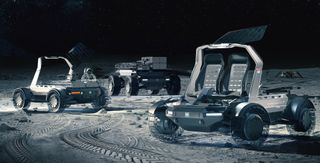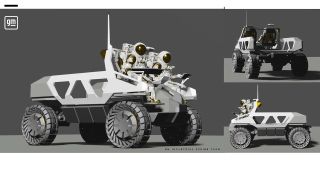GM is designing a fleet of vehicles for the moon. Here's what it will look like
The only car company to put a vehicle on the moon is planning a sequel

Someday, there’s going to be a traffic jam on the moon. Lunar station wagons lined up behind lunar school buses lined up behind lunar race cars, deadlocked in the center of Lunar Base Alpha, or whatever NASA calls its first permanent settlement. Which raises an interesting question: How do you honk a horn in space?
Fortunately, someone’s already working on the answer. Jeff Nield is Director of Product and Experience at GM, and lately he’s consumed with one thing: lunar buggies. And he’s asking all the questions: How do you inflate tires in space? And the really out-there questions, too. Does it have turn signals? Is there a parking lot somewhere? Do we need license plates?
“What about turn signals and bumpers,” he told TechRadar. “You have to think about traffic and following another vehicle.” Above all else, one thing seems to preoccupy Nield: collisions.
“We have to navigate … how do we avoid bringing them into contact, how do we avoid putting a dimple in the mesh tires? How do we avoid low-speed contact?”
To build the world's most advanced vehicle to ever drive on the moon, he's turned the clock back 50 years, to the first vehicle GM helped build for Apollo 15 – and leaning on cutting-edge technologies such as virtual and augmented reality, 3D printing, and more.
Ask most people about lunar vehicles, and they’ll likely revert to 7-year-olds with crayons, mentally drawing George Jetson’s hovercraft or that thing from Lost in Space. Let's leave it to the pros, okay? GM Defense agreed in May to team up with Lockheed Martin to build the next generation of lunar vehicles to transport NASA astronauts on the surface of the moon, fundamentally evolving and expanding humanity’s deep-space exploration footprint.
“This alliance brings together powerhouse innovation from both companies to make a transformative class of vehicles,” said Rick Ambrose, Executive Vice President, Lockheed Martin Space. “Surface mobility is critical to enable and sustain long-term exploration of the lunar surface. These next-generation rovers will dramatically extend the range of astronauts as they perform high-priority science investigation on the moon that will ultimately impact humanity’s understanding of our place in the solar system.”
Get daily insight, inspiration and deals in your inbox
Get the hottest deals available in your inbox plus news, reviews, opinion, analysis and more from the TechRadar team.
But it’s not just a single vehicle, Nield tells us. He’s thinking about the future: multiple vehicles, serving different purposes, tooling around the landscape. That’s the ultimate vision of the Artemis program – a lunar colony. And only one car company has ever built a vehicle for the moon. So what will cars look like in our next civilization?
Building a fleet for the moon
Fifty years ago for the Apollo 15 mission, GM helped build the Apollo Lunar Terrain Vehicle (LTV) that let astronauts explore the lunar surface farther and faster than ever before. The craft folded in half, and then in half again, to squeeze into a tiny compartment on the lunar rover; after unpacking it, the car drove 4.7 miles across the dusty, barren, frigid expanse of the moon. GM remains the only car company to have set its mark on the moon, history that isn’t lost on Nield.
In preparation for the project, his team met with surviving members of the Apollo mission and studied the original vehicle. Designed to withstand the vacuums of space, the 14-day long lunar nights where the temperature drops to minus-167 Celcius (minus-250 Fahrenheit), and the omnipresent, super-sticky lunar dust, that first vehicle was a gem. Sure, it only went 8 miles per hour, with 0.25 horsepower per electric motor per wheel (a grand total of 1hp), but it was a marvel of functionality.
A lot of vehicles have a hard time doing what we call ‘surviving the night’
Jeff Nield, GM Head of Industrial Design
“Our job is not to eliminate things that have been proven on the lunar surface. It’s to add stuff in other spaces,” Nield said. The temperature extremes are a critical challenge, both the baking 121C-degree heat of daytime, but especially the freezing nights that drag on and on.
“A lot of vehicles sent have a hard time doing what we call ‘surviving the night,’” he told TechRadar. “We want something that can survive the night. It needs to charge via solar, hibernate, and come back to life.”
But Nield’s sweating the details, too. Consider the controls in your car; the auto industry has been moving to touchscreens, and steering wheels and pedals are the ordinary way we pilot vehicles. Neither work in space, of course. Astronauts also wear bulky spacesuits to protect themselves from cosmic radiation, as well as extreme temperatures, so touchscreens are out of the question. And pedals are hard to push, much less finesse to control speed.
“We started looking at the best way to control a vehicle without using your feet. The original rover had a T handle – forward, reverse, and steering, almost like a helicopter control. Our team’s going to try to find a more intuitive way to do that,” Nield says.

And they’re moving to analog push buttons, rather than touchscreens that also wouldn’t work given the volume of dust on the moon. But how far apart are the buttons? How deep are they? What sort of haptic feedback will register best through a lunar spacesuit?
"We’re going back to haptics, hyper simplicity,” Nield says. “We want people from different backgrounds to control the vehicle very easily. That’s also key in an emergency situation.”
A future on the moon (and Mars)
Sending human explorers 400,000-plus kilometers to the moon is hardly an undertaking to tackle lightly. Yet NASA’s Artemis program is heavy on ambition, with a target landing date of 2024 - just two years from now. That timing has suffered some setbacks, notably a lawsuit with SpaceX that mucked things up a bit. In November, NASA Administrator Bill Nelson delayed things ... but only a bit.
"With the recent lawsuit and other factors, the first human landing under Artemis is likely no earlier than 2025,” Nelson said.
That still seems optimistic, but the project is moving with incredible speed, Derek Hodgins, Manager of Lunar Mobility Strategy at Lockheed Martin, told TechRadar.
"Right now, engineers from Lockheed Martin and General Motors are developing our Lunar Mobility Vehicle to meet readiness for humanity’s return to the Moon’s surface by 2025," Hodgins said. The team plans to build "the most advanced vehicle to ever drive on the moon," he noted – and to do so requires cutting-edge technology.
To move quickly, the team has embraced modern technology: The GM design team put a digital prototype together in two weeks using HTC Vive augmented reality headsets, Unreal Engine for modeling, and Autodesk’s industrial design software including Alias and VRED.
Using the headsets, they were able to stand next to their prototypes to gauge size and proportion. “We’ll go from digital to full size really quickly,” he said.
Time is the biggest challenge, in more ways than one. Beyond the launch window that looms down the road, there’s the half-century span between the last lunar rover and this one.
“I can’t think of any other project that took a 50-year pause,” Nield said. He’s right. But if Artemis succeeds, there won’t be a break after this mission – and your next vacation might be otherwordly.

After 25 years covering the technology industry, Jeremy Kaplan is a familiar face in the media world. As Content Director for TechRadar, he oversees product development and quality. He was formerly Editor in Chief of Digital Trends, where he transformed a niche publisher into one of the fastest growing properties in digital media. Before that, he spent half a decade at one of the largest news agencies in the world, and cut his teeth in magazine business, long before the birth of the iPhone. In 2019, he was named to the FOLIO: 100, which honors publishing professionals making an industry-wide impact.
Most Popular


